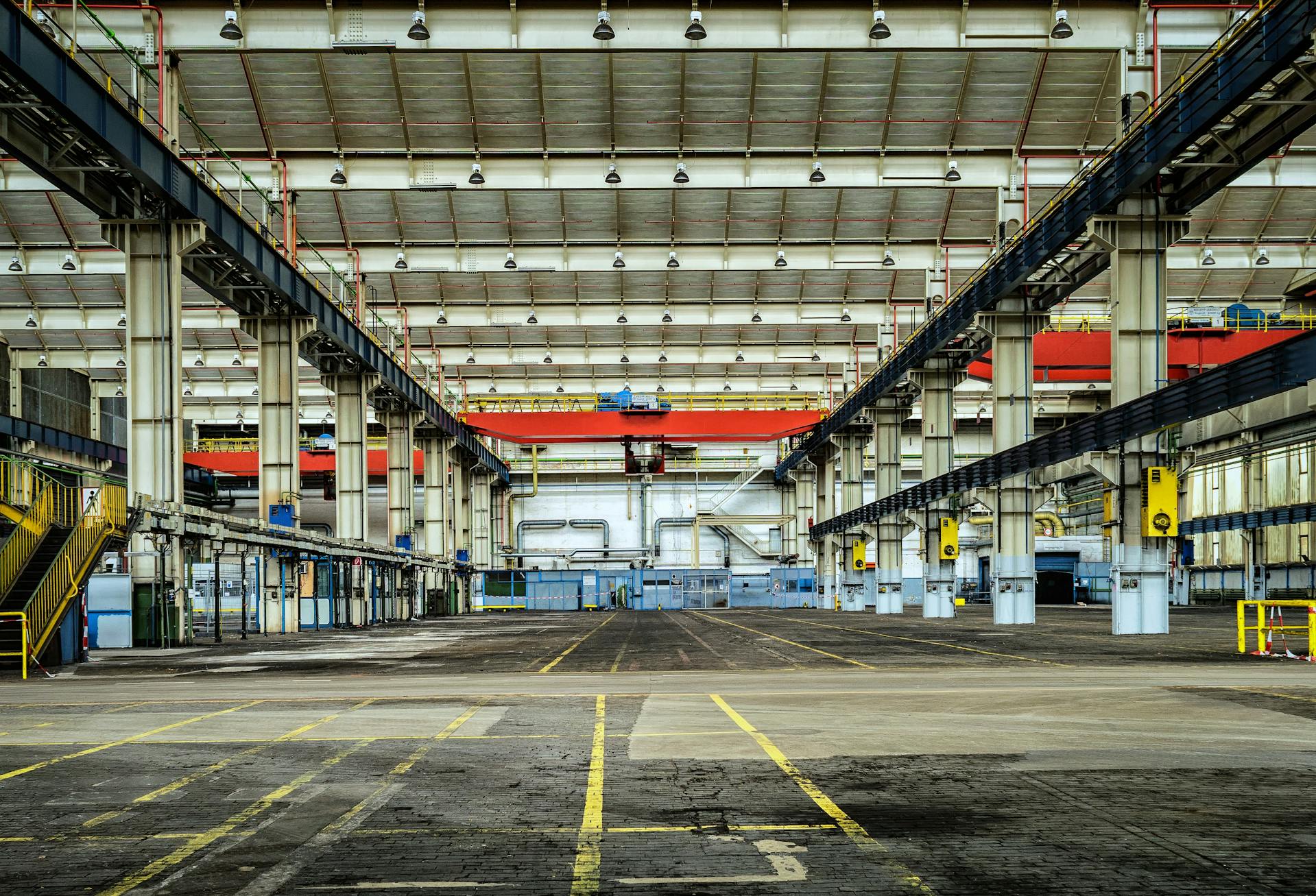A business must focus on safety infrastructure during warehouse setup operations. Guard rail systems shield workers and equipment from expensive accidents that may halt operations for multiple days or weeks.
The warehouse safety market is booming. The global Warehouse Guard Rail market size reached $1.2 billion in 2024 and is expected to grow to $2.5 billion by 2033 while experiencing an annual compound growth rate (CAGR) of 8.8% between 2026 and 2033.

Here’s the problem:
Warehouses managers usually put storage space optimization first but neglect safety barriers until incidents happen. OSHA reports that approximately 100,000 forklift-related injuries happen annually in the United States which demonstrates the critical necessity for dependable safety barriers including guard rails within warehouse settings.
Without proper guard rail protection, warehouses face:
- Equipment damage from collisions
- Worker injuries and liability issues
- Inventory loss from rack collapses
- Costly downtime and repairs
What you’ll discover:
- Understanding Guard Rail Kit Components
- Load Requirements and Safety Standards
- Installation Methods That Actually Work
- Maintenance Tips for Long-Term Protection
Understanding Guard Rail Kit Components
Guard rail kits consist of carefully designed parts that work together as a comprehensive safety solution. Quality warehouse guardrail systems contain specific components designed to work together as a complete safety solution.
Here’s what matters most:
Functional guard rail kits contain posts, rails and mounting hardware which have been engineered to handle specific impact forces. Posts represent the structural foundation of the system requiring exact sizing to endure anticipated forces. The distribution of impact forces across multiple anchor points through rails prevents single-point damage to the entire barrier system.
The mounting hardware joins all system components while affecting load transfer efficiency to floors and structural bases. Quality kits use galvanized steel components to combat corrosive elements found in warehouses where chemical exposure and moisture combined with temperature shifts destroy inferior materials.
But here’s what most people don’t realize…
The performance of the system relies significantly on how far apart the posts stand from one another. The rails lose their ability to handle impact loads when there is excessive space between posts. Installing posts at too close an interval results in higher installation costs without adding any safety improvements. Railing systems should install posts at distances ranging from 6 to 8 feet depending on both rail height and expected impact forces.
Different warehouse areas require different rail configurations. Protective systems at loading docks need to withstand forklift collisions and trailer backing impacts. Storage aisles need to have lighter protection systems to keep pedestrians from entering hazardous zones. Equipment zones near conveyor systems need specialized configurations to protect both machines and personnel.
Load Requirements and Safety Standards
What mistake do warehouse managers commonly make when selecting guard rail kits?
Warehouse managers select guard rail systems based on cost instead of the necessary load specifications.
Here’s what actually matters:
The design of guard rail systems requires them to fulfill precise load standards that match their designated applications. OSHA regulations dictate required impact loads which safety barriers must endure without failing. These standards function as legal requirements which establish protections against liability for both workers and employers.
Most warehouse guard rails must handle:
- 10,000-pound impact loads for vehicle barriers
- 6,000-pound loads for equipment protection
- 200-pound loads per linear foot for pedestrian areas
- Additional uplift resistance in seismic zones
But load requirements tell only part of the story. The installation method determines whether a guard rail system can actually achieve its rated capacity. Surface-mounted systems rely on anchor bolts and concrete strength. Core-drilled installations transfer loads deeper into the slab. Each method has specific applications where it works best.
Temperature matters more than people think.
Warehouse environments subject guard rails to extreme temperature swings. Loading docks see freezing conditions in winter and scorching heat in summer. These cycles cause metal expansion and contraction that can loosen fasteners and stress weld joints. Quality systems account for thermal movement in their design.
Installation Methods That Actually Work
The primary cause of guard rail installation failures stems from flawed planning rather than product defects.
As e-commerce expands and warehouses grow larger, guard rail systems become more commonly implemented. Workplace accidents decline when businesses implement stricter safety regulations including OSHA standards thereby increasing the need for guard rails.
Surface mounting works when:
Guard rail system concrete slabs require a minimum thickness of 6 inches and proper curing conditions. The mounting surface requires a level surface without any existing fractures or repair marks. Anchor bolts achieve full embedment depth because they remain unobstructed by rebar and conduits.
Rapid installation of surface-mounted systems allows users to minimize initial expenditure. Systems achieve peak performance when installed in locations where impact conditions range from light to moderate. Surface mounting results in concentrated loads at specific locations which causes concrete surfaces to fail under intense impacts.
Core-drilled installations handle heavy loads better.
Concrete holes enable the insertion of posts which systems then secure with structural adhesive or grout. The installation technique takes more time and resources but achieves improved load distribution with deeper embedment.
Core-drilled posts provide top-notch results in areas with high machinery activity including frequent forklift operations. Core-drilled systems exhibit better fatigue failure resistance and deliver stable performance against impact loads compared to surface-mounted systems.
Planning saves money and prevents problems.
Successful installations start with proper site analysis. Testing procedures verify that concrete has the required thickness and strength levels. The practice of identifying existing utilities during location checks protects against expensive drilling damages. By analyzing traffic patterns installers can identify the installation sequence that will reduce disruptions during the process.
Installation problems usually happen because unforeseen site conditions were not considered during the initial planning stages. Hidden conduits force post relocations. Thin concrete requires different anchor systems. Corrosion damage which reduces system longevity emerges from substandard drainage conditions.
Maintenance Tips for Long-Term Protection
How often guard rails receive maintenance affects their operational life span more than initial construction quality. High-quality systems fail prematurely if neglected, while average systems can operate for decades when properly maintained.
Visual inspections catch problems early. Monthly inspections help find loose bolts, damaged rails, and corrosion before costly breakdowns occur. Check for bent rails indicating impacts, ensure post bases remain intact by examining concrete for cracks or anchor bolt movement, and inspect paint systems for rust bleeding or coating failure.
All impact damage needs urgent attention regardless of size. Rail bends compromise structural strength despite short-term operation capability. Minor collisions deteriorate joint connections and diminish future load-bearing capacity.
Cleaning extends system life significantly. Warehouse environments are harsh on metal surfaces. Cleaning products, road salt, and industrial processes create chemical exposure that accelerates corrosion. Regular cleaning prevents contaminants from causing permanent surface damage.
Power washing effectively eliminates dirt and debris. Use low-pressure settings to prevent water infiltration at connection points, which causes hidden corrosion. Apply protective treatments only after surfaces fully dry.
Touch-up painting stops small repairs from escalating into larger maintenance needs. Keep matching paint available for rapid application when damage occurs. Remove all dirt before applying primer to exposed metal surfaces.
Bringing It All Together
The choice of guard rails determines warehouse safety performance as well as operational efficiency and future expenses. A proper system safeguards workers and equipment while reducing maintenance needs and operational interruptions.
Establish safety goals and budget constraints before beginning the project. Initiate protection in high-risk areas and extend coverage as resources become available. Proper installation of quality systems ensures reliable service for decades while requiring minimal maintenance.
The swift expansion of the warehouse sector generates numerous possibilities along with various obstacles. Guard rail protection ensures facilities achieve efficient operations that enable business expansion and safeguard both workers and valuable assets.
Quality guard rail systems enable businesses to achieve peace of mind and maintain operational continuity which leads to sustainable success.

Founder Dinis Guarda
IntelligentHQ Your New Business Network.
IntelligentHQ is a Business network and an expert source for finance, capital markets and intelligence for thousands of global business professionals, startups, and companies.
We exist at the point of intersection between technology, social media, finance and innovation.
IntelligentHQ leverages innovation and scale of social digital technology, analytics, news, and distribution to create an unparalleled, full digital medium and social business networks spectrum.
IntelligentHQ is working hard, to become a trusted, and indispensable source of business news and analytics, within financial services and its associated supply chains and ecosystems










